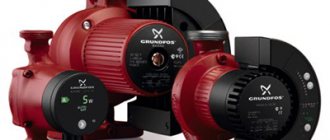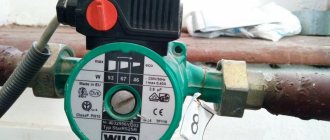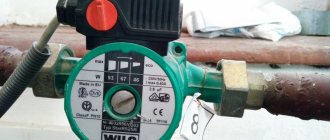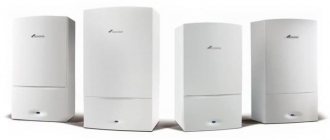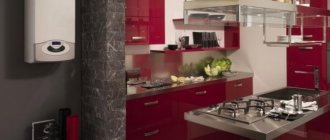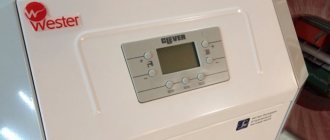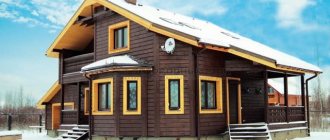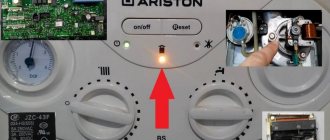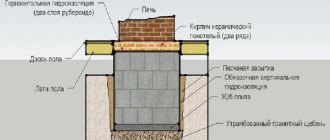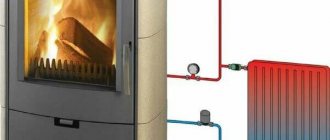Circulation pumps have long been used in organizing heating systems in homes. They are necessary to improve the temperature regime of the boiler, use complex heating circuits and make it possible to hide communications in the floor or walls. This equipment is now installed even in places where previously natural coolant circulation was quite sufficient.
Users have noticed that thanks to the pump, the heating system becomes more efficient and economical: the pipes are heated better and the load on the boiler is reduced. On the modern market you can find a wide variety of this type of equipment from different manufacturers. For example, you can purchase a Grundfos circulation pump that has good performance.
Frequently asked questions about heating systems
- Is the pump pressure equal to the height of the building?
Modern heating systems are designed as hydraulically closed systems. This means that the height of the building is not taken into account when designing the pump.
When determining the pressure of heating pumps, the most important factor is the resistance of the piping system, including the resistance of its individual components, that is, fittings and bends.
- How can I remove a clogged heating pump/wet rotor pump?
Turn off the power supply to the pump. Remove the screw in the center of the nameplate. Underneath there is a shaft with a groove. After inserting a screwdriver into the groove, turn the shaft in the direction of rotation until the blockage is completely removed.
A little about the brand
If you translate the word Grundfos from Danish into Russian, it will sound like “Spring”. The concern was founded in 1945. Now the brand is represented in 45 countries, the company occupies a leading position as a manufacturer of pumps for heating, hot water supply and sewerage.
The main function of the manufactured equipment is the efficient delivery of water, both drinking and domestic, for various needs. The brand is constantly researching new materials and technologies, which allows it to produce innovative equipment that meets all modern quality standards. As a result, the user receives efficient, reliable, energy-saving devices.
Selecting a pump installation location
Opinions on this issue are completely opposite. Most are confident that the only correct solution is at the inlet of the domestic boiler, on the so-called “return” line. Although supporters of installing a circulation pump at the outlet of the unit argue that the location of the device at the supply makes heating more efficient. Who is right?
From the point of view of the laws of physics (there is such a discipline as hydraulics), this is not fundamental. In any case, the impeller will “pump” the coolant through the pump, that is, ensure the movement of liquid along a closed circuit. But taking into account the peculiarities of the operation of a domestic boiler, its “reaction” to emergency situations arising in the heating system, the circulation pump should be installed only on the “return”, that is, at the inlet of the unit.
Why? The circulation pump is designed to work with liquid media. In the event of an emergency, the coolant may boil, and steam will form at the boiler outlet, which will enter the heating system. The pump will cease to perform its function, since the impeller is not able to pump gaseous media. As a result, circulation in the circuit will stop, which will lead to an even greater increase in temperature in the heat exchanger. Next (if the automation did not work) - the boiler explodes. But if the pump is installed on the return line, then the risk that steam will “get” to it is reduced to zero.
Conclusion - from the point of view of safe operation of boiler equipment, the circulation pump should be installed only on the “return”, that is, on the pipe connected to the inlet pipe of the unit. Even if the heat generator is the latest model, with the most advanced automation, it is inappropriate to rely only on it. What if he refuses? After all, no one will argue that none of the technical means is 100% reliable.
Review of popular models
The devices produced by this company have gained popularity all over the world. They are used in heating systems of country houses, cottages and industrial premises. At the moment, Grundfos produces several lines of equipment with different parameters and features.
UPS 25–60 180
Grundfos UPS 25 60 180 is a circulation pump whose body can be made of two materials. The cast iron version is used for heating, and the stainless steel device is used for the hot water system. The design includes an induction motor, a 3-speed shifter and a sleeve that separates the rotor from the starter.
Mounted in both vertical and horizontal planes. Using this model, you can pump coolant of various temperatures: from +2 to +110 °C.
Advantages:
- Suitable for closed and open loop;
- made from high-quality materials that are resistant to wear and corrosion;
- economical - consumes 60 W;
- low noise - no more than 43 dB;
- compact - 18 × 13 × 13 cm;
- has a light weight - 2.6 kg;
- protected from overheating thanks to a “wet” rotor cooled by a coolant;
- easy to install and maintain;
- has a long service life - up to 10 years.
The performance parameter of this unit is 4.3 m3 per hour. The maximum pressure is 5.6 m. The device consumes 0.06 kW of electricity.
This range of pumps, like the UPS 25 80 180, is used in heating and air conditioning systems. Units with bronze and stainless steel bodies are also suitable for domestic hot water supply.
Circulation pumps Grundfos UPS 25 40 180 mm and 25 60 180 are sold at prices starting from 9020 rubles.
UPS 32–40 180
This equipment is suitable for heating and hot water systems. It should be noted that the design does not provide a prefilter, so the coolant must be of high quality: without foreign particles, not viscous and not aggressive.
The UPS 32-40 180 is a single-stage, three-speed model. The user can, if necessary, change the shaft rotation speed, thereby adjusting the performance of the device. For the pump to work properly, it needs to constantly pump liquid - it is the coolant that washes and lubricates its ceramic-graphite bearings.
The model is equipped with a wet rotor. Installation is very simple and does not require additional protective elements - the unit is resistant to current blocking. The almost silent operation of the pump will not distract the user from his work.
Key benefits:
- easy installation;
- easy adjustment of shaft rotation speed;
- built-in protective module;
- no maintenance required;
- The design includes a thermal relay;
- high quality and durable parts;
- efficiency.
This is a compact device that can operate for 10 years without causing problems during operation.
Specifications:
- throughput – 2.72 m3 per hour;
- power – 25 W;
- head – 3.9 m;
- dimensions – 12.6 × 14.1 × 18 cm;
- weight – 2.6 kg.
The circulation pump for heating Grundfos UPS 32–40 180 has a price of 7,200 rubles.
UPS 32–60 180
Thanks to its innovative design, the model is considered universal for all systems: heating, hot water supply, air conditioning. The equipment casing is made from various materials and is selected depending on the operating conditions. In addition, the device is suitable for working in conjunction with a “warm floor” system.
All structural parts are made of high-quality, corrosion-resistant materials. Even if the pump runs around the clock, it can last at least 10 years. Users note that the device is silent - this is an important advantage for domestic use.
Characteristics:
- power – 50 W;
- throughput – 3.35 m3 per hour;
- head – 5.75 m;
- maximum coolant temperature - up to +95 °C;
- weight – 2.6 kg;
- installation - vertical or horizontal.
UPS 32–60 180 has proven itself excellent for domestic purposes. Its power is sufficient for efficient operation of the heating circuit.
Advantages:
- easy connection to the network;
- Thanks to ceramic bearings, silent operation is ensured;
- long service life, for which high-quality design elements and materials are responsible
- there is a motor winding that protects it from current blocking;
- the ability to set the desired rotation speed;
- When starting, unnecessary air is removed from the pump.
You can buy this model at a price of 7,740 rubles.
UPS 40 120 F
This is a small-sized flanged model, characterized by quiet operation and economical energy consumption. The device's motor has a wet rotor and a protected stator. Instead of seals, 2 O-rings are used.
The pumped liquid serves as a lubricant for the bearings. To make the design more reliable, the manufacturer minimized the number of parts. UPS 40 120 F is suitable for heating and air conditioning.
Peculiarities:
- It’s easy to choose the right model based on various parameters;
- 3-speed electric motor;
- ceramic bearings (radial);
- the thrust bearing is made of carbon;
- cast iron body;
- built-in thermal relay on the stator.
Like other products, this line, despite its high power, operates almost silently.
Characteristics:
- power – 470 W;
- throughput – 19 m3 per hour;
- head – 12 m;
- coolant temperature - up to +120 °C;
- weight – 19.1 kg.
This model is suitable for connecting to the heating circuit of a large country house or cottage. Price - from 33,060 rubles.
UP 15–14 BUT
This compact unit circulates liquid for the hot water system. The UP 15 14 BUT pump has a built-in timer and thermostat. Using a timer, the user can program the operation of the device. The task of the thermostat is to automatically maintain the set temperature.
A distinctive design feature is a spherical electric motor, which does not use bearings.
Advantages:
- If service is required, the electric motor can be easily removed;
- Corrosion-resistant material is used to manufacture the impeller;
- body made of bronze;
- heat-insulating casing included.
The single-phase electric motor of this unit does not require additional protection; it is already provided by the manufacturer.
Characteristics:
- power - 25 W;
- maximum pressure - 10 bar;
- protection class - IP42;
- weight - 1 kg;
- head - 1.2 m;
- liquid temperature - up to +95 °C;
- throughput - 0.5 m3 per hour.
The cost of this model for domestic hot water starts at 7,080 rubles.
UPA 15–90 N
The scope of application of this unit is heating, heating, air conditioning and hot water supply. The design is such that the impeller of the device comes into contact with the coolant, allowing it to respond more quickly to changes in the system.
Peculiarities:
- 3 stages of speed adjustment;
- presence of built-in thermal protection;
- compact dimensions;
- resistance to corrosion.
The functional task of this model is to increase the pressure in the system. The device turns on and off automatically, you just need to open or close the tap. Thanks to its quiet operation, it can be installed even in an apartment.
Characteristics:
- power – 0.118 kW;
- head – 8 m;
- productivity – 1.8 m3 per hour;
- pressure – 6 bar;
- protection - IP 42.
Price UPA 15 90 N - from 7500 rubles.
ALPHA2 L 25–40 180
This is not only a convenient, but also a high-performance model on the market today. In addition to its compact size, the device is characterized by excellent performance. Thanks to its innovative design, the unit is suitable for heating and domestic hot water, as well as air conditioning and refrigeration.
Advantages:
- easy installation;
- consumes minimal electricity;
- high efficiency, which is achieved thanks to the frequency converter, the most compact stator and permanent magnets;
- the technical parameters of the device are automatically adapted to the features of the system;
- easy control - just one key;
- the presence of a display on the case, which is necessary to monitor the work.
Any user can install this pump, as it is equipped with a proprietary plug designed specifically for this line. Automation of equipment involves operation in “night mode”, which significantly saves energy consumption.
Characteristics:
- power - from 5 to 22 W;
- head – 4 m;
- productivity – 2.4 m3 per hour;
- pressure – 10 bar;
- weight – 2.3 kg;
- protection - IP42.
Price ALPHA2 L 24-40 180 - from 7600 rubles.
ALPHA3 25-40 130
This is an updated version of the previous model, which has become even more functional and technologically advanced. The pump supports two-way data transmission and 2 mobile applications. That is, through a smartphone, the user has the opportunity to set the operating parameters of the device, which greatly facilitates its use.
There are 3 control modes for different circuits: with radiators, “warm floors” and with a combined circuit. ALPHA3 automatically adapts to the heating circuit, optimizing energy consumption. Thanks to the mobile application, you can set the operating schedule of the device.
Advantages:
- simple remote control;
- night and summer operating modes for various systems;
- dry running protection;
- energy efficient and reliable permanent magnet electric motor;
- presence of built-in thermal protection;
- connection via a special plug;
- The equipment is equipped with threaded connections.
Thanks to innovative hydraulic balancing, this model allows you to save up to 20% of fuel, which significantly reduces operating costs.
Characteristics:
- power – 18 W;
- head – 4 m;
- productivity – 2.6 m3 per hour;
- pressure – 10 bar;
- weight – 2 kg.
The price starts from 19,580 rubles.
Magna
This range includes small, medium and large pumps for commercial installations. Each model is equipped with communications and variable speed motors.
Setting up the equipment is very simple - just connect it and leave the factory settings, additionally activating the AUTOADAPT mode. As a result, the pump itself will adjust its own settings taking into account the characteristics of the system. This will allow you to achieve an optimal level of comfort and minimal energy consumption.
Magna is flexible and reliable, has a long service life and requires no maintenance. Thanks to the built-in IR communication system, expansion modules can be connected to the device, thereby simplifying its operation.
Peculiarities:
- pressure and temperature regulation;
- various operating modes;
- the electric motor does not require external protection;
- complete with thermal insulation casing;
- efficiency;
- TFT display;
- convenient control panel;
- possibility of connecting several pumps.
At the moment, the Magna line includes several models with different characteristics. In one hour, the equipment is capable of supplying up to 70 m3 of water with a maximum pressure of up to 18 meters. The operating pressure indicator is no more than 16 bar.
Price Grundfos Magna3 25–40 - from 39,700 rubles.
Recommendations for pump installation procedure
This work should be done in the so-called “off-season”. But if there is a need to carry out the installation during the heating season, the boiler needs to be “turned off” and wait until the temperature of the coolant drops - these are basic things that do not need additional comments.
- If it is necessary to install a bypass, it is better to assemble it separately, installing all the fittings and the circulation pump. All that remains is to make an insert into the pipe.
- The next stage is bleeding the air while simultaneously monitoring the system to detect leaks.
After this, you can safely switch the circuit to work with a pump.
Harness
There are two types of heating systems - forced and natural circulation. Systems with forced circulation cannot work without a pump; systems with natural circulation work, but in this mode they have lower heat transfer. However, less heat is still much better than no heat at all, so in areas where electricity is often cut off, the system is designed as hydraulic (with natural circulation), and then a pump is installed into it. This gives high heating efficiency and reliability. It is clear that the installation of a circulation pump in these systems is different.
All heating systems with heated floors are forced - without a pump, the coolant will not pass through such large circuits
Forced circulation
Since a forced circulation heating system without a pump is inoperative, it is installed directly into the gap in the supply or return pipe (of your choice).
Most problems with the circulation pump arise due to the presence of mechanical impurities (sand, other abrasive particles) in the coolant. They can jam the impeller and stop the motor. Therefore, a mesh dirt filter must be placed in front of the unit.
Installing a circulation pump in a forced circulation system
It is also advisable to install ball valves on both sides. They will make it possible to replace or repair the device without draining the coolant from the system. Turn off the taps and remove the unit. Only that part of the water that was directly in this piece of the system is drained.
Natural circulation
The piping of the circulation pump in gravity systems has one significant difference - a bypass is required. This is a jumper that makes the system operational when the pump is not working. One ball shut-off valve is installed on the bypass, which is closed the entire time the pumping is running. In this mode, the system operates as forced.
Installation diagram of a circulation pump in a system with natural circulation
When the electricity goes out or the unit fails, the valve on the jumper is opened, the valve leading to the pump is closed, and the system operates as a gravity system.
Installation features
There is one important point, without which the installation of the circulation pump will require rework: it is necessary to rotate the rotor so that it is directed horizontally. The second point is the direction of flow. There is an arrow on the body indicating which direction the coolant should flow. This is how you turn the unit so that the direction of movement of the coolant is “in the direction of the arrow”.
The pump itself can be installed both horizontally and vertically, just when selecting a model, make sure that it can work in both positions. And one more thing: with a vertical arrangement, the power (pressure created) drops by about 30%. This must be taken into account when choosing a model.
Operating modes
A modern recirculation pump for heating is a multifunctional device. Various samples of this equipment are capable of operating in the modes indicated in the passport, including “fixed speed”. All of them are equipped with a synchronous motor, the operation of which is controlled by a built-in processor. During operation of the unit, the control unit records the following main parameters:
- current strength;
- rotor speed;
- temperature in the working area and others.
Its presence allows you to adapt to a specific heating network with optimal energy consumption.
Connecting the main line to the water supply system
The pipe from the well to the residential building is pulled along a trench. The depth of the latter should be below the freezing level of the soil. On rocky soils, the pipe is usually run from the top, only slightly buried into the ground. , a heating cable must . It is very expensive. Therefore, in dachas that are rarely visited in winter, the pipe is sometimes simply wrapped in cotton wool, laid in a channel made of wooden sleepers, and then the whole thing is covered with sawdust. But, of course, in this case there is still a high risk of the highway freezing. Especially in cold winters with little snow. The line is connected to the storage hydraulic tank via a pressure switch with a pressure gauge.
Specifications
The main technical indicators that attention is paid to when choosing a suitable equipment model are:
- graph of the dependence of liquid pressure on the amount of liquid supplied to the system;
- power consumed by the unit’s engine from the network;
- coolant performance;
- permissible temperature of the pumped medium;
- dimensions and weight of the device.
Devices are selected by power depending on the volume of water pumped.
The first of the characteristics allows you to understand what volumes of water are pumped by the pump depending on the pressure developed in the system. The higher this indicator, the less water resource must be passed through the unit to obtain the required pressure. To correctly select a sample of equipment, the operating point must be located under the graph curve. When choosing this indicator, it is advisable to ensure a supply margin of at least 20%. Another parameter is directly related to it - pump performance.
The power taken from the network is determined by the amount of current in the load and the supply voltage (220 or 380 Volts). This parameter is taken into account when selecting current protection devices for power supply circuits and when calculating the cross-section of wires included in the power supply lines. The performance of pumping equipment depends on this value, increasing with its increase.
The dimensions of the purchased sample and its weight are also taken into account when choosing a suitable model. This also applies to the operating conditions of the pump – the minimum and maximum permissible temperature of the pumped medium. The reliability and durability of the purchased sample depends on the correct selection of this indicator.
Where to put
It is recommended to install a circulation pump after the boiler, before the first branch, but on the supply or return pipeline it doesn’t matter. Modern units are made from materials that can withstand temperatures up to 100-115°C. There are few heating systems that work with a hotter coolant, so considerations of a more “comfortable” temperature are untenable, but if you feel safer, put it in the return line.
Can be installed in the return or direct pipeline after/before the boiler up to the first branch
There is no difference in hydraulics - the boiler, and the rest of the system; it makes absolutely no difference whether there is a pump in the supply or return branch. What matters is the correct installation, in the sense of strapping, and the correct orientation of the rotor in space. Nothing else matters.
There is one important point regarding the installation location. If the heating system has two separate branches - on the right and left wings of the house or on the first and second floor - it makes sense to install a separate unit on each, and not one common one - directly after the boiler. Moreover, the same rule remains on these branches: immediately after the boiler, before the first branch in this heating circuit. This will make it possible to set the required thermal conditions in each part of the house independently of the other, and also in two-story houses to save on heating. How? Due to the fact that the second floor is usually much warmer than the first floor and much less heat is required there. If there are two pumps in the branch that goes up, the speed of movement of the coolant is set much lower, and this allows you to burn less fuel, without compromising the comfort of living.
history of the company
The history of Grundfos dates back to 1945. Danish engineer Paul Du Jensen set up a small production facility called "Bjerringbro Pressestoberi og Maskinfabrik", which translated means: press casting and machining factory in Bjerringbro.
Initially, the engineer was engaged in the development and production of pumping equipment only. Quality and a non-standard approach to solving many problems related to the design and size of devices have made the company's products very popular. Production grew, there were more and more consumers.
Until 1967, the Dane renamed his company several times. And only this year the name Grundfos appeared, which still exists.
According to world statistics, pumps from this company account for 50% of global consumption. Why? Quality has already been mentioned. But there is another reason - the company has turned into an international concern. Factories, factories, and small assembly shops are scattered all over the world. Russia was no exception. A representative office was established in Moscow in 1992, which grew into a subsidiary with the opening of a plant near the city of Istra.
